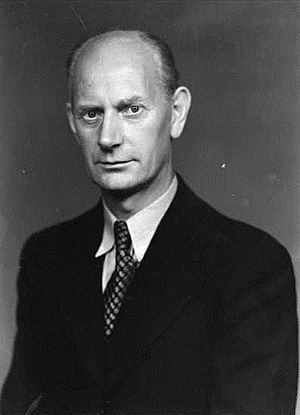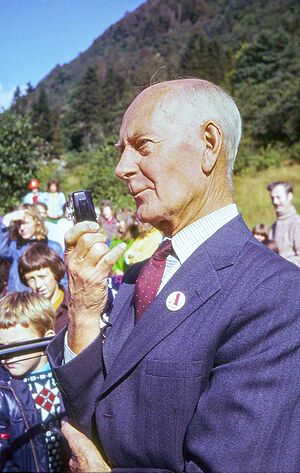Einar Gerhardsen facts for kids
Quick facts for kids
Einar Gerhardsen
|
|
|---|---|

Gerhardsen in 1945.
|
|
| 22nd Prime Minister of Norway | |
| In office 25 September 1963 – 12 October 1965 |
|
| Monarch | Olav V |
| Preceded by | John Lyng |
| Succeeded by | Per Borten |
| In office 22 January 1955 – 28 August 1963 |
|
| Monarch | Haakon VII Olav V |
| Preceded by | Oscar Torp |
| Succeeded by | John Lyng |
| In office 25 June 1945 – 19 November 1951 |
|
| Monarch | Haakon VII |
| Preceded by | Johan Nygaardsvold |
| Succeeded by | Oscar Torp |
| President of the Storting | |
| In office 16 January 1954 – 22 January 1955 |
|
| Monarch | Haakon VII |
| Prime Minister | Oscar Torp |
| Preceded by | Gustav Natvig-Pedersen |
| Succeeded by | Oscar Torp |
| Leader of the Labour Party | |
| In office 28 May 1945 – 27 May 1965 |
|
| Preceded by | Oscar Torp |
| Succeeded by | Trygve Bratteli |
| President of the Nordic Council | |
| In office 1 January 1954 – 31 December 1954 |
|
| Preceded by | Hans Hedtoft |
| Succeeded by | Nils Herlitz |
| Member of the Norwegian Parliament | |
| In office 4 December 1945 – 30 September 1969 |
|
| Deputy | Hjalmar Larsen Aase Lionæs Gunnar Alf Larsen Herman Pedersen |
| Constituency | Oslo |
| Personal details | |
| Born |
Einar Henry Gerhardsen
10 May 1897 Asker, Akershus, United Kingdoms of Sweden and Norway |
| Died | 19 September 1987 (aged 90) Oslo, Norway |
| Resting place | Vestre Gravlund |
| Political party | Labour |
| Spouse |
Werna Gerhardsen
(m. 1932; died 1970) |
| Children | 3, including Rune |
| Profession | Civil servant Road worker |
Einar Henry Gerhardsen (10 May 1897 – 19 September 1987) was a very important Norwegian politician. He served as the 22nd prime minister of Norway three times. His time in office was from 1945 to 1951, 1955 to 1963, and 1963 to 1965. In total, he was Prime Minister for 16 years. This makes him the longest-serving Prime Minister in Norway's history since the country became a parliamentary democracy.
He was also the leader of the Labour Party from 1945 to 1965. Many Norwegians called him "Landsfaderen," which means "Father of the Nation." He is seen as one of the main people who helped rebuild Norway after World War II. He also served as the second President of the Nordic Council in 1954.
Contents
Who was Einar Gerhardsen?
Early Life and Family
Einar Gerhardsen was born in Asker, a town in the Akershus region of Norway. His parents were Gerhard Olsen and Emma Hansen. His father worked for the Public Roads Administration. He was also a leader in a trade union. Because of this, union leaders often visited their home.
In 1932, Einar married Werna Julie Koren Christie. They had two sons, Truls and Rune, and a daughter named Torgunn. Einar's brother, Rolf Gerhardsen, also worked closely with him throughout his life. Einar became interested in politics when he was 17. He joined the Labour Party's youth movement.
Political Beginnings and Imprisonment
Einar Gerhardsen started his career as a road worker. In the 1920s, he became very active in the socialist labour movement. He was involved in political protests. Over time, he and the Labour Party shifted their focus from communism to democratic socialism. This meant they wanted to achieve their goals through democratic elections, not revolution.
In 1932, he was elected to the Oslo city council. By 1938, he became the deputy mayor. The Labour Party grew very strong in Norway. From 1935, they were the main party in government.
When Germany occupied Norway in 1940 during World War II, Einar Gerhardsen became the acting leader of the Labour Party. He was also made Mayor of Oslo in August 1940. However, the German occupation government quickly forced him to resign. They also banned all political parties, including the Labour Party.
During World War II, Gerhardsen joined the organized resistance against the German occupation. He was arrested on 11 September 1941. He had been questioned many times before this. He was sent to Grini concentration camp in Norway. Later, he was moved to Sachsenhausen concentration camp in Germany. He was questioned and treated harshly, but he did not give away information about the resistance. In 1944, he was sent back to Grini, where he stayed until the war ended.
After the war, in May 1945, Gerhardsen formed a temporary government. This government led Norway until the general election in October 1945. The Labour Party won a large majority in the Storting (the Norwegian Parliament). They kept this majority until 1961. Gerhardsen also served as the President of the Storting from 1954 to 1955.
Norway's Post-War Leader
Building a New Norway

Einar Gerhardsen was highly respected by the Norwegian people. His governments created a unique economic policy. They regulated businesses, industries, and banks. His policies helped reduce poverty and unemployment. They did this through industrialisation and by sharing wealth more fairly. This was done using progressive taxation, where people with higher incomes pay a larger percentage in taxes. His government also built a strong social security system.
Many important laws were passed during his time as Prime Minister:
- In 1946, a law made it easier to get cheap loans for housing.
- Also in 1946, a law introduced payments for families with more than one child. Single-parent families also received help.
- In 1947, unemployment insurance was expanded to include more workers.
- A loan fund for students was created in 1947.
- Housing allowances were introduced for families with children.
- In 1954, a law started a trial for nine-year comprehensive schooling.
- In 1956, health insurance became required for everyone.
- In 1960, a pension plan for people with disabilities was introduced.
- In 1961, accident coverage was extended to military personnel.
- In 1957, basic pensions for everyone were introduced.
- An orphans' pension scheme was set up in 1957.
- In 1964, a national benefit for widows was introduced.
Foreign Policy and Challenges
In foreign policy, Gerhardsen decided to align Norway with Western countries in the late 1940s. Norway became a founding member of NATO, a military alliance.
In 1962, a mining accident happened in the Kings Bay coal mine. 21 miners died. Gerhardsen's government was criticized for not following safety laws. In 1963, a vote of no confidence passed. This meant the Parliament no longer supported his government. A new government was formed, but it only lasted three weeks. Gerhardsen returned as Prime Minister. However, in the 1965 election, the opposition won.
Gerhardsen retired from national politics in 1969. But he continued to share his ideas through writing and speeches. His political ideas are still very important in Norway today.
Later Life and Legacy

Einar Gerhardsen spent his last years in Oslo. He passed away on 19 September 1987, at the age of 90. He is buried in Vestre gravlund. His legacy is that he helped shape modern Norway into a fair and prosperous country.
See also
 In Spanish: Einar Gerhardsen para niños
In Spanish: Einar Gerhardsen para niños
- Johan Nygaardsvold
- Oscar Torp
Images for kids

